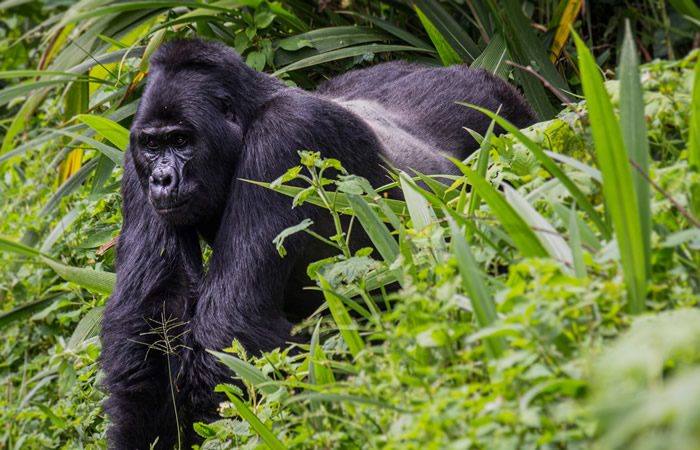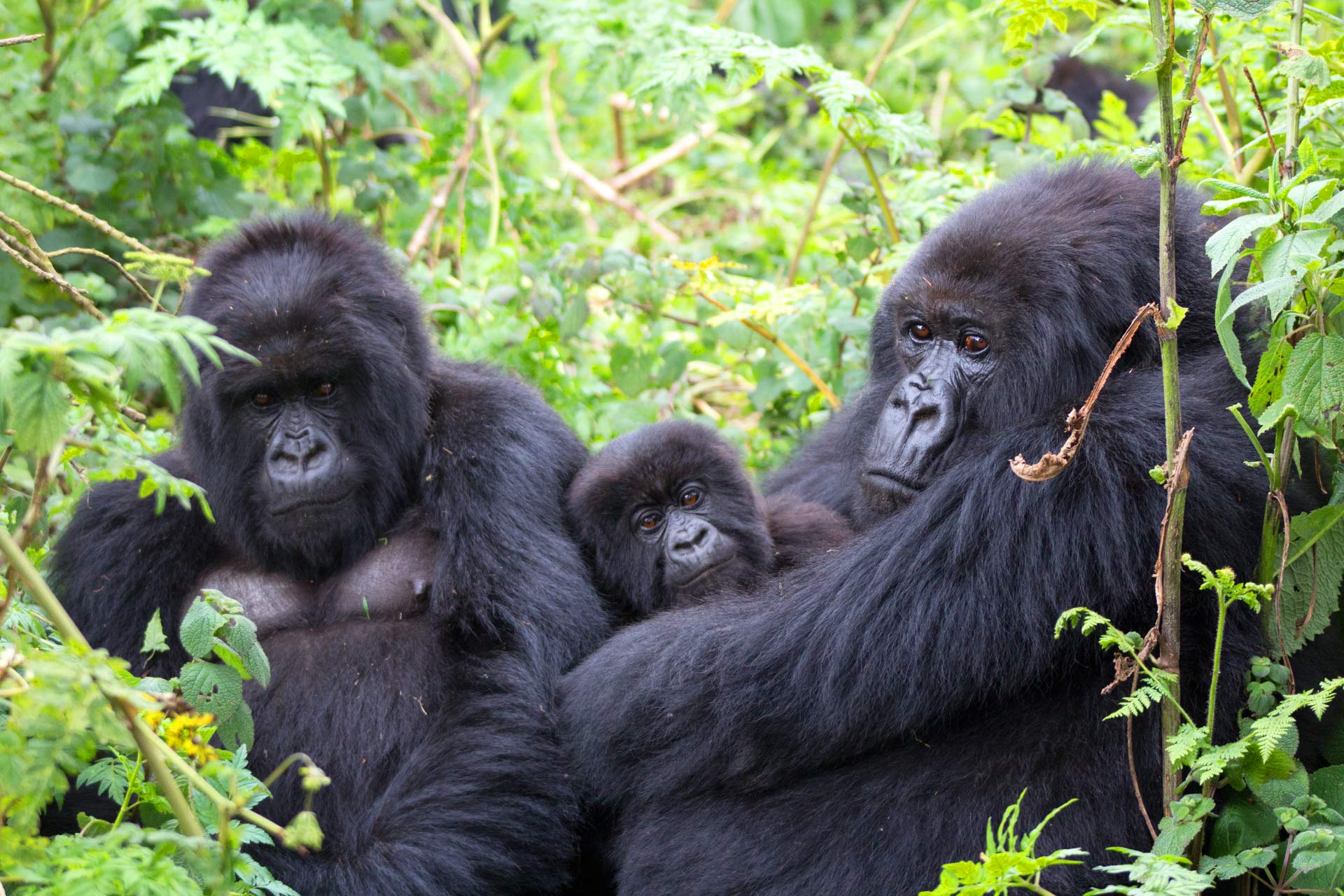Which Country In Africa Has More Mountain Gorillas? Based on the results of a recent census, there are currently around 1000 mountain gorillas in Africa. Although Rwanda and the Democratic Republic of the Congo are home to mountain gorillas, Uganda is home to about half of them. Mgahinga National Park and Bwindi Impenetrable National Park are home to Uganda’s mountain gorilla population. Only 19 gorilla families are habituated and available for tourists at this time. Two gorilla families are currently available for habituated experiences in the southern section of Bwindi Forest.

There are twelve gorilla families in Volcanoes National Park that welcome tourists to see the Rwandan mountain gorillas. Six gorilla families in Virunga National Park are home to DRC mountain gorillas, who have fully acclimated to their surroundings and are now accessible to tourists.
There were only 250 mountain gorillas left in the 1980s, according to a census, and the history of gorilla trekking in Africa indicates that these animals were in danger of going extinct. After conducting this mountain gorilla census, American primatologist Dian Fossey and her team arrived at this conclusion.
Conservation took precedent, and the mountain gorillas were included on the global list of critically endangered primates. However, the ongoing civil upheaval in the Virunga region at the time, particularly the 1994 Rwandan Genocide, disrupted this conservation strategy.
Beginning in the early 1990s, the Ugandan gorilla tracking journey involved acclimating gorillas to their new environment until 1993, when the Mubare gorilla family was first made accessible to tourists. After being fully acclimated, the other three gorilla families—Rushegura, Habinyanja, and Nkuringo—opened to visitors. There are currently 19 gorilla families in Uganda that are accessible to tourists for trekking.
HOW MANY GORILLA FAMILIES ARE IN UGANDA?
The world’s mountain gorilla population is almost half found in Uganda, where the greatest habitat is found in Bwindi Impenetrable National Park. These mountain gorillas can be found in the following areas of Bwindi Impenetrable National Park:
- the Buhoma area in the north,
- the Ruhija area in the east,
- the Rushaga area, and
- the Nkuringo area in the south.
A number of families with mountain gorillas reside in Uganda, including the Rushegura, Mubare, Oruzogo, Bitukura, Nshongi, Bweza, Chrismas, and other families. There is only one gorilla family in Mgahinga National Park, and their name is Nyakagezi.
A new census of mountain gorilla populations in Uganda indicates that there are an estimated 459 mountain gorillas there, up from about 400 in the 2011 census. As more babies are born and fatalities are reported, this figure is continually rising.
A few families of mountain gorillas have fully acclimated to their new environment and are available for public gorilla trekking. In Uganda, 19 gorilla households have allowed visitors as of yet.
Two gorilla families in Uganda are also available for gorilla habituation safaris. Travelers can track a family of semi-habituated mountain gorillas on a gorilla habituation safari. They are accompanied by veterinarians, researchers, and trackers.
HOW MANY GORILLA FAMILIES ARE IN VIRUNGA NATIONAL PARK?
The Virunga region includes Virunga National Park in the Democratic Republic of the Congo as well as Volcanoes National Park in Rwanda. About 605 mountain gorillas were counted as residents of the Virunga region during the most recent mountain gorilla census. Because of the recorded births and deaths of mountain gorillas, their population is growing.
Approximately twelve gorilla families are accessible to tourists in Rwanda, and permits can be obtained for any of them. There are numerous gorilla families in Rwanda, including the Muhoza, Agasha, Amahoro, Susa, and Sabyinyo.
HOW CAN I BOOK GORILLA PERMITS FOR UGANDA, RWANDA, AND THE D.R. CONGO?
Procedures:
- Select the number of companions you plan to go on this safari with, as well as the day you would like to go gorilla trekking.
- Contact the Rwanda Development Board or Uganda Wildlife Authority with an inquiry, or get in touch with a reputable tour operator such as Focus East Africa Tours. We relieve you of the responsibility of confirming availability and putting together the remaining elements of a gorilla trekking safari package.
- Depending on the date you choose, our safari expert looks into the availability of gorilla permits in Rwanda or Uganda.
- We urge clients to get their gorilla permits as soon as possible if the status of their availability is positive, in order to ensure they receive all the perks. Due to increased demand from all over the world, mountain gorillas are becoming increasingly rare over time; nevertheless, each gorilla family can only have 8 gorillas every day.
- Submit certain personal information later on, such as nationality, birthdate, names as they appear on the passport, passport expiration date, and so on. A portion of this data is included on the certificate you receive after finishing the gorilla trekking; it is utilized for record-keeping purposes.
WHERE TO GO FOR GORILLA TREKKING IN AFRICA
In Uganda
Bwindi Impenetrable National Park: Uganda’s mountain gorillas reside in Bwindi Impenetrable National Park. The majority of the world’s mountain gorilla population is found in this forested national park. The Park is located in Uganda’s southwest.
The Ruhija area, the Rushaga area, the Nkuringo area, and the Buhoma area are the areas that make up Bwindi Forest.
Prior to booking lodging for your gorilla trekking experience in Bwindi Impenetrable National Park, you need to be aware of where the permit is reserved. This is due to the challenge of maintaining a connection when hopping from one location to another in order to make the early morning briefing.
Olive baboons, chimpanzees, blue monkeys, grey-cheeked mangabeys, L’Hoests, red-tailed monkeys, and other primates exist in this park, which is a rich primate habitat.
In Bwindi Impenetrable National Park, there are twice as many opportunities for gorilla trekking and birding for even the most ardent birdwatchers. Within this park, there are about 350 different types of birds. The best place to go birdwatching in the Bwindi Forest is the Ruhija area, especially if you choose to hike to the Mubwindi marsh.

Mgahinga National Park: This mountain gorilla residence, which occupies an area of roughly 33.7 square kilometers, is one of the smallest. The park’s unique backdrop of volcanic mountains makes for breathtaking beauty. These mountains are called Gahinga, Mountain Muhabura, and Mountain Sabyinyo.
In this park, there is only one family of gorillas that is accessible for tourists to observe: the Nyakagezi family. This family of mountain gorillas used to stray into Rwanda, but they have been residing in Mgahinga National Park consistently. Because of its untouched vegetation, Mgahinga National Park offers mountaineering, birdwatching, and scenic gazing in addition to gorilla trekking.
In Rwanda
In Rwanda, the only place where mountain gorillas live is Volcanoes National Park. The Park is located in Rwanda’s northwest. Volcanic highlands make up its topography, with the mountains being among the most notable features. Volcanoes National Park is home to five of the six Virunga ranges: Kirisimbi, Bisoke Mountain Sabyinyo, Mountain Muhabura, and Mountain Gahinga.
In Rwanda, there are presently about 12 gorilla families available for gorilla trekking. Several families are among them: the Agashu family, the Karisimbi family, the Umubano family, the Her family, and so on.
In this Rwandan National Park, more than 200 bird species, including endemic species from the Albertine Rift, can be found. The gorilla trekking experience and the birding expeditions in this park are also enjoyable for ornithologists. Other primates, including black and white colobus, golden, blue, red-tailed, and olive baboons, can be seen in Volcanoes National Park.
In the Democratic Republic of the Congo
One of the world’s four remaining mountain gorilla habitats is Virunga National Park. There are now six gorilla families in this national park that are accessible to tourists.
The process of gorillas becoming accustomed to Virunga National Park has been hindered by the insecurity in this region. This explains why there aren’t many gorilla families there that are open to tourists. The Mapuwa, Lulengo, Rugendo, Munyaga, Kabirizi, and Humba families are among the gorilla families found in Virunga National Park.
WHICH IS THE BEST COUNTRY TO DO GORILLA TREKKING IN AFRICA?
Going gorilla trekking in Uganda, Rwanda, or the Democratic Republic of the Congo doesn’t compare to the experience of being in front of the last remaining mountain gorillas. You temporarily forget the difficulties you may have had in your search for the mountain gorillas after spending an hour with them. During gorilla trekking, a few of the variables that distinguish the three mountain gorilla habitats are as follows:
The gorilla permit costs
At present, the cost of a gorilla permit in Rwanda is $1500 per person for each trip, whereas the gorilla permit in Uganda is $700 per person for each trek, and the gorilla permit in the Democratic Republic of the Congo is $450 per person for each trek.
It takes time to get to the mountain gorilla habitats.
It takes roughly three hours to get from Rwanda’s airport to Kigali along beautiful, winding roads. It takes roughly eight to nine hours to drive from Uganda’s Entebbe Airport to either Mgahinga National Park or Bwindi Impenetrable National Park. If you don’t go via Kigali airport in Rwanda, the drive to Virunga National Park from any airport in the Democratic Republic of the Congo could take days.
Security in the gorilla trekking destinations
The DRC’s Virunga National Park has security issues as a result of ongoing civil conflict. The gorilla trekking experiences in this region are being slowed down by this. Nonetheless, the political climates in Rwanda and Uganda have long been favorable, and gorilla trekking safaris are secure.
Number of gorilla families open for tourism.
There are nineteen gorilla families in the DRC Congo, about twelve in Rwanda, and nineteen in Uganda that are open to tourists. Because there are more gorilla families in Uganda during the peak season, there is a greater chance of receiving a gorilla permit there.
Extra Activities in Safari to Combine with Gorilla Trekking
You can combine gorilla trekking with a range of other optional activities available in Uganda, such as wildlife drives, birding, mountaineering, and chimpanzee trekking. Activities on the Africa Safari are restricted to Rwanda and the Democratic Republic of the Congo.
WHAT ARE THE DON’TS OF GORILLA TREKKING SAFARIS IN AFRICA?
- No, going into the forest without a ranger guide to accompany you. The forest is home to animals like forest elephants that are not accustomed to human presence and could hurt you.
- Since flora serves as food for mountain gorillas, it is prohibited to spit on it. They can eat soft stems, leaves, tubers, and other plants, although they are mostly vegetarians and consider bamboo to be a delicacy.
- It is banned to make noise while gorilla trekking to avoid frightening the revered mountain gorillas about unfamiliar things happening nearby.
- It is against the law to litter the forest with trash, since doing so changes the ecosystem in which mountain gorillas find food. Avoid throwing plastic wrappers into the forest as well.
- When you find the mountain gorillas, stay 8 meters away from them and move carefully away if they come near you. This lessens the possibility of infecting the gorillas, who are quite vulnerable to illnesses from humans.
- It is not permitted to use flash photography because it could frighten the mountain gorillas, who can become disturbed by such things.
- One strategy to prevent the mountain gorillas from contracting human infectious diseases like COVID-19 is to wear a clean mask in their presence.
- Given that mountain gorillas are wild animals in quest of food, it is recommended that you eat or smoke at least 200 meters away from them.
- The mountain gorillas are only allowed to spend an hour with visitors, leaving them to go about their regular lives of eating, grooming, reproducing, and other tasks.


